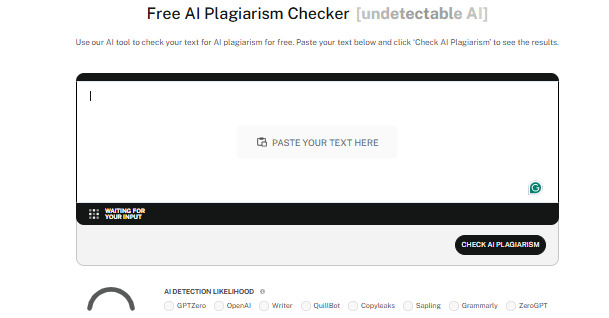As Ralph Waldo Emerson once said, “Sometimes a scream is better than a thesis.” While it’s ironically the case for many, writing a thesis is basically the culmination of your hard work.
There’s a certain pride in accomplishing such a task, and many people hold it close to their hearts throughout their lifetimes.
This showcases a student’s ability to contribute original insights to their field and opens many more doors to broaden their academic and professional opportunities. Finishing a thesis certainly has weight.
The great thing about education today is that technology can help make things easier. AI tools, for instance, can assist with writing research papers and doing thesis work.
Even teachers can utilize the power of AI to improve their ways of teaching – but more on the exciting AI stuff later.
What you need to start with for your thesis is to create a strong introduction. Your thesis intro sets the tone for your entire work, so getting it right is important.
Here’s everything you need to know on how to write a thesis introduction that instantly catches the eye and informs effectively at a glance.
Key Takeaways
- A strong thesis introduction sets the tone and establishes context, research questions, and objectives.
- Start with an engaging hook, provide background, and explain the significance of your topic.
- Include clear aims, objectives, and why your research matters to your field or real-world issues.
- Refer to your thesis proposal, know your audience, and maintain a formal academic tone.
- AI tools can assist with writing and proofreading, but use detectors like Undetectable AI to ensure originality.
What Types of Information Should Be Included in Your Thesis Introduction?
After days and nights of researching, typing, and editing, the general average thesis length ends up at around 20-50 pages.

A PhD dissertation, usually tougher, can go up to 90-500 pages long. That’s a lot of work.
With so much information to showcase, your thesis intro should be able to make a big impression. A weak introduction can mislead your readers and even diminish the value of your entire thesis.


Never Worry About AI Detecting Your Texts Again. Undetectable AI Can Help You:
- Make your AI assisted writing appear human-like.
- Bypass all major AI detection tools with just one click.
- Use AI safely and confidently in school and work.
As the first impression of your work, the intro sets the stage by providing some context, highlighting the research problem, and laying out your objectives clearly.
It can be intimidating just thinking about it, so we’re here to make sure your thesis intro delivers the punch it needs. Here are some things that you should include.
Have an attention-grabbing opening
In the marketing world, you’ve got just 8.25 seconds to capture attention—the average focus time for most adults today. In a world overflowing with content, that’s all the time you get.
While your teacher won’t drop your thesis if your introduction doesn’t grab them within seconds, having a great opening can still make a strong impact.
The main goal here is to present a compelling hook that sparks curiosity.
Include a surprising statistic, engage with a thought-provoking question, share a short but relatable anecdote, or try to be daring and make a bold statement that shocks but relates to your research topic.
There are many ways to do it, but ultimately, you want to engage your reader right from the start.
Provide context and the importance of the topic
“In this thesis, we will be exploring the effects of social media on communication.” Why, though? And what part of social media are we talking about here?
This is a bad example of a thesis intro because it lacks context.
Instead of simply choosing a controversial or topical subject to make an impact, you need to go deeper straight away.
The goal of providing context is to guide your reader in understanding why your topic is worth discussing in the first place.
You can offer a brief overview of already existing research and how you can add to it, and also show the gaps and unresolved issues that your study aims to fix.
Highlighting your topic goes to show that it’s an important matter to discuss in your field.
Engage through specific questions that your research addresses
One of the best ways to make your thesis intro stand out is by asking specific questions.
For example, if your research is about the effects of social media on traditional media, rather than just stating it outright, you can start off with an engaging question like “Is social media ending the age of the newspaper?”
In this way, you instantly grab the attention of your reader with a compelling question while still providing a sense of what your research will be about.
It’s a two-punch combo of showing immediate purpose and relevance while making your thesis intro easy to follow.
Frame your research in the form of specific and engaging questions so you can lay the groundwork for a more focused thesis.
Thesis Introduction Tips

So far, a good thesis introduction should be able to outline the main topic clearly, present some compelling questions, and provide context and significance for the study.
It’s definitely not easy, but there are ways to make it more doable. Here are some handy thesis introduction tips to help you out.
Know your audience
Knowing your audience means that you understand who will be reading your thesis. By doing this, you can create an introduction that meets their expectations and interests.
When writing a thesis intro, you should be able to consider the background, knowledge level, and interests of the thesis readers – your advisor, committee members, and other related academics.
Knowing this, you can set the right tone, which is usually formal, and engage in a way that interests them.
Refer to your thesis proposal or notes
If you want to make a seamless thesis paper, you will constantly need to refer to your proposal and notes.
You should refer to all the preliminary work that you’ve done to direct the writing of your introduction.
This can include your research questions, objectives, literature review, and methodology that you’ve outlined for your proposal.
It’s always important to go back and review your thesis notes regularly because these help you:
- Ensure that your thesis introduction is consistent with your original proposal.
- Present the main elements of your research.
- Organize your thoughts and create a well-structured introduction, contributing to your overall thesis flow.
Keep your thesis proposal and notes by your side. They will help you create a strong introduction that provides clear context for your research.
Use Assistant AI tools to help with writing and proofreading
Especially when it comes to writing, AI tools have become quite useful.
You might already be familiar with ChatGPT, which uses advanced algorithms to generate the needed content; it can even proofread text.
AI tools can be useful to writers and researchers by offering suggestions and writing parts of the work that they can improve later.
This makes the writing process a whole lot more efficient and much less time-consuming. With AI, you can essentially produce high-quality work under tight deadlines.
However, while AI tools are clearly helpful, it’s necessary that you still use them responsibly.
AI Plagiarism Checker is a growing concern that happens when any AI-generated content is presented as original work without giving the right acknowledgment.

This can severely damage the credibility of your research and even get you in trouble.
Treat AI as what it’s intended to be – a tool – rather than the main writer of your work. You should still be the writer of your own work.
To avoid any issue with AI, a reliable detector like Undetectable AI can be used to always make sure that your content passes as human-written.

Undetectable analyzes any text you submit to effectively detect AI content. It also includes features like a humanizer that adjusts the writing to match a natural human tone.
We certainly don’t want to stop you from maximizing your potential with the help of AI, so with a useful AI detector and humanizer by your side, you can always get the results you want.
Make sure you clearly state your topic, aims, and objectives
This one is essential. Your thesis introduction should be able to clearly define what your research is about (topic), what you plan to accomplish (aims), and the steps you’re taking to get there (objectives).
It’s pretty straightforward and is a no-brainer, but you must do this for several reasons:
- Helps your readers understand the focus of your research right from the get-go.
- Sets clear expectations for your thesis.
- Establishes relevance, making your work highly credible.
- Easier assessment (whether you’ve achieved your goals) by your advisor and evaluators.
Remember, a well-defined introduction is your first step toward a successful thesis. Make it matter.
Explain why your research matters
If your thesis doesn’t make an impact in your field, then it might not be seen as valuable. So, from the start, be sure to explain why your research matters.
This provides a basis for why you’re choosing a specific topic in the first place and explaining why it deserves their attention.
To help, you can also link your research to real-world applications or social issues to enhance its appeal to the research community and beyond.
3 Thesis Introduction Examples to Inspire You

Writing a thesis introduction can be quite a challenge, but looking at examples can help you understand how to start your research on the right foot.
Communications Example
“Is social media ending the age of the newspaper?” This question frequently arises in discussions as the communication landscape continuously evolves.
Platforms like Facebook, X (previously called Twitter), and Instagram continue to grow, and their impact on traditional media – newspapers, television, and radio – becomes more significant and complex.
Social media has drastically changed how people access information. Unlike traditional media, which professional journalists and editors usually produce, social media allows anyone to create and share content.
This shift has huge implications for both media producers and consumers. Understanding these changes is important for professionals in the field and the general population.
This thesis aims to answer several questions: How has social media affected the credibility of traditional news sources?
What strategies are traditional media adopting to compete in a digital world? And how do today’s audiences perceive news found on social media vs traditional platforms?
By addressing these questions, this research seeks to provide a comprehensive understanding of the current media landscape and provide some discourse on the future of communication and modern-day responsible journalism.
Environmental Science Example
Food production is one of the largest contributors to environmental damage.
The methods that we traditionally use to grow and raise our food have serious implications for resource use, greenhouse gas emissions, and land use.
So, we ask the question, “Can our food choices save the planet?”
As global populations rise and climate change accelerates, understanding the environmental impact of different food production systems has never been more important.
Plant-based agriculture and animal-based agriculture differ considerably, so studying these differences can help identify sustainable practices that minimize and ultimately prevent environmental damage.
This thesis aims to address how plant-based and animal-based food production systems compare in terms of resource use and environmental impact and what practices within these systems can reduce their impact on the environment.
Education Example
The global pandemic has made a dent in how we live, and that includes the state of education.
During this difficult time, schools and universities worldwide were essentially forced to shift to online learning almost overnight.
This sudden and widespread adoption of online learning presents a unique opportunity to assess its effectiveness and impact on education – past the pandemic.
If online learning is actually shown to be effective, it could lead to more flexible, accessible, and inclusive educational practices.
Conversely, if notable shortcomings are identified, this can highlight areas that need improvement to support students and educators better.
This thesis aims to identify the effectiveness of online learning in achieving educational outcomes compared to traditional classroom settings, as well as the major challenges faced by students and educators during this transition.
It also examines how factors such as socioeconomic status and access to technology influence the overall effectiveness of online learning.
With this study, we can provide valuable insights into the strengths and weaknesses of online education, contributing to the broader discussion of post-pandemic learning.
Be sure to check out our AI Detector and Humanizer in the widget below!
FAQs
How do you start an introduction for a thesis?
To start a thesis introduction, start with a hook that draws the reader in and sets the stage for your research topic.
Provide context by discussing the significance of the topic. Then transition into your thesis statement, which outlines the main argument or purpose of your research.
What is an example of a thesis statement in an introduction?
An example of a thesis statement in an introduction could be:
“This thesis examines how social media platforms like Facebook, Instagram, and X (formerly Twitter) have reshaped how individuals interact and form relationships in the digital age, with an emphasis on interpersonal communication.”
Clearly state the main focus and purpose of your research and provide a roadmap for the reader to understand what will be discussed in your thesis.
What is a good way to start a thesis statement?
You could start a thesis statement by introducing your topic and talking about the specific angle you plan to explore in your research.
Grab the reader’s attention and establish why it’s worth investigating further.
How do you start writing a thesis?
Writing a thesis starts with choosing a topic that interests you – and then aligns with your field.
Be sure that the main goal of your thesis stays relevant to gain some credibility. With this, you can create a clear thesis statement that outlines the main objective of your study.
This is where you can start drafting a compelling thesis introduction and then filling your content with strong arguments that are supported by evidence and analysis.
Firmly conclude with a summary of your findings and their implications. Always cite your sources accurately and follow the academic guidelines.
Conclusion
Maximizing the potential of your thesis always starts with an introduction, and with the help of AI tools, you can be confident to write a strong one.
When using these tools, just be sure to have Undetectable AI by your side so that any content you need assistance with stays authentic.
Before you finalize, use Undetectable AI’s AI Humanizer and AI Plagiarism Checker to ensure your thesis introduction remains natural, original, and credible.
Remember to tailor your thesis introduction to your specific research topic and audience, and use examples and evidence to back up your claims.
With these strategies in mind, you’ll be well-equipped to write an impactful thesis introduction – paving the way for a great thesis.
Start with Undetectable AI today and make your writing future-proof.
